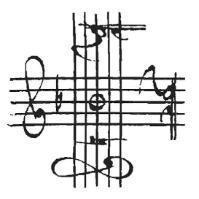Leaderboard
Popular Content
Showing content with the highest reputation on 11/05/2023 in all areas
-
After a good long while of waiting for the ideas to come back, here we are! I'm rather proud to announce the completion of my symphony's first movement. It's been a good long while since I last posted about progress on this symphony, and I think it's about time I broke the ice and post the finished product here. I'm fully intending on finishing this symphony by the end of the next two years or so, but I'm taking a break from symphonic writing for now (because it drains my will to compose like no other). I'll be returning to form and focusing on writing for smaller ensembles (and piano covers!) while waiting for the ideas to start emerging for the second mvt. to this symphony, so hopefully I'll be able to post more after this. That being said, this piece is obviously far from truly finished: it's only a quarter of the struggle, after all. I'll be looking forward to reading all of your comments and criticisms as per usual. I can't wait to get through them all! (Also, to@Henry Ng Tsz Kiu: I owe this one to you! 😁)2 points
-
This might actually be my best current composition. It is my weirdest piano piece for sure. I built the harmonies and "melodies" from a chromatic superset (3+4+5). I can explain it better if I see interest. It took me around 5 hours to compose this piece and I have to say that it is a true nightmare to learn it and play it without many mistakes. I pray for the people who decide to start learning it hahaha. Some of the jumps are actually scary. The piece has an improvisatory nature like some of my other compositions, but this time it is easier to imagine a horror plot behind it. Also I think there is no official performance version of the work, you can play it very different to the way I played it today. Here you have a performance a friend of mine recorded: I hope you enjoyed it! Let me know if you have any doubt or advice.2 points
-
Hi everyone, I've not been on here much recently owing to work and life, but I've been working on this piece where possible. Hope you all enjoy it but I'd love any feedback you might have! This is probably my last foray into "vanilla Classical" for a little while as I'd like to experiment a bit before returning to my "roots". I think this is successful, I put a lot of effort into overall structure, and thematic material - I think where it might be lacking is in textural variety. I didn't intend for a particularly virtuosic piano part and so I'm happy with the part the piano plays (intentionally the piece is very much shared between solo and orchestra, with the development intentionally where the two main themes sort of battle it out. https://www.youtube.com/watch?v=t7E2UQ7fiKI I've had a little bit of fun with this video using free use videos, but attaching the score in case it is too difficult to follow the score closely on the video! Dan1 point
-
After such a long time without login in, i finally came up with a piece that wasn't trash. This is one of the piece i will show in my access test. I wrote the theme and some of the variations (maybe six in the final score) trying each one to have a distinct motive/character, there are some melodic movements i need yet to fix. Ignore the chinese hanzi in the title hahaha. - Samuel Tema con Variaciones.mp3 Tema con Variaciones.pdf1 point
-
Hi everyone! I'm here to present my most recently finished work, the first movement of my String Sextet in G-flat major. I name this piece a subtitle of Heaven, Earth and Human to express my view on their relationship. (What a self bragging guy this is...) The piece is dedicated to my friend Johnson Ho. Guys and gals, please help me pray for his declining health and wish him all the best. He is definitely one of the reason why I start this piece and the reason why I finish this piece. Special thanks to @Thatguy v2.0 with his always original ideas which sparked my inspirations and new thoughts. Every time after discussion he always gives me new ideas on my composition and musical idea. And he's the one who make this audio perfect in my opinion. Thx so much and I'm so happy I get to know you in this forum and become friends with you as my musical guidance. I will post the mp3, pdf and YT video here first since I'm going to brag all those details after it haha🤣: Final First Draft of First Movement of String Sextet.pdf Final final first draft 01-06-2023 First Movement of String Sextet in G flat major.mp3 https://youtu.be/cI8MAn2XEPk If you don't want to read them, just ignore them!! (spoiler alert)😀😃😄😁😆😂🤣🥰😍🤩😘🤑😵🤢🤮🥶😨😱😭(spoiler alert) (spoiler alert) 😀😃😄😁😆😂🤣🥰😍🤩😘🤑😵🤢🤮🥶😨😱😭 (spoiler alert) (spoiler alert) 😀😃😄😁😆😂🤣🥰😍🤩😘🤑😵🤢🤮🥶😨😱😭 (spoiler alert) (spoiler alert) 😀😃😄😁😆😂🤣🥰😍🤩😘🤑😵🤢🤮🥶😨😱😭 (spoiler alert) (spoiler alert) 😀😃😄😁😆😂🤣🥰😍🤩😘🤑😵🤢🤮🥶😨😱😭 (spoiler alert) This piece is inspired by the thoughts of the great New-Confucian Chinese philosopher, Tang Chun-i. I immerse much in his philosophy and am always delighted reading his huge books. This work is particularly inspired by his thoughts of 9 states of mind, and I really hope I can depict what I feel towards the ninth state, the state of Heavenly(天) Morality Transcending (sorry for my bad English Translation... but this is way too technical for my standard....), his philosophy and Chinese thoughts in general. I choose G-flat major as the tonic since 1)the initial inspiration comes in this key, 2)it's the key of transcendence for me, 3) I want the sound less bright by get rid of those open strings notes, since truth for me is Aletheia in Heideggerian sense, which is hidden but to be disclosed only, rather than a bright thing to have. I know there are some discussions concerning key choice of strings recently, so I'm clarifying here. I had my initial thoughts for this piece in 2021 May when I woke up midnight, but then I was busying with my composing of Clarinet Quintet in C minor and thus ignored it. I wished to continue it in 2022 August after finishing my Quintet, but find it real hard to continue since I don't have the craft to do it. Until I joined YC and saw the following two posts: (Hey Jean @Jean Szulc I said I would learn something from your piece, and this is the product!!!!🤘🤘🔥🔥 Thank you! Will you post here again?) (Yo Vince my bro!!!🤘🤘 Thank you!) These two are absolutely great pieces (go check for them! Vince's piece is still on the "Our Picks" section) and they use the quartal harmony so well. I also learn from Jean's piece on the more extended techniques for strings. Then I had some ideas to finish the piece. This one gonna be something Chinese which is weird in a sense that despite being a Chinese I never write something Chinese. It's always Beethovanian and I really would like to reduce that element in my new piece. After writing the Clarinet Quintet in C minor, especially after having complete an all-controlling piece (esp. the 4th movement), I realized that I have too much reliance on forms and motives and I hope I can make them less explicit in my new piece. I love sonata form very much, but you cannot compose every pieces in it. And for me all the hard work pays off. For the instrumentation is two violins, two violas and two cellos. I love how the addition of 1 extra viola and cello (to a standard String Quartet) thickens the voice and strengthen the middle and low registers. It also gives more chance for viola and cello to sing while having their partners doing the accompaniment. For me the violins stand for the Heaven, violas stand for human and cellos stand for earth, though this is not mandatory interpretation of the piece as it's not always strict imagery. The structure of this piece is more a 3 part one. I have added some rehearsal marks on it to indicate the parts, and I will describe below with some (hopefully) interesting thoughts: (Timepin according to the video) First Section: 00:06 A, main theme. The accompanying texture comes from the first movement of Brahms's String Quintet no.2, one of my favourite of his piece. It starts with viola to emphasize the human call for me. Notice the theme in viola II in 00:23. That theme will appear throughout the whole movement. (Is this a Qi(氣) theme?)00:31 another important theme. 00:38. I like this theme for its contemplative nature. The theme comes from my Clarinet Quintet in C minor. Can you find it? I find it two days before in a wonder LoL. 00:54 B, continuation in high register with added voice. 01:24 C, transition, old theme disguised as a new one. 01:54 D, in D flat major/Mixolydian. The "Heaven" section in my original planning. 02:36 E, continuation in G flat major. 02:59 F, I love the conclusion in 03:13 very much. Modulate to C major to next section in 03:42 and I love the transition so much since it's real hard to compose. 03:42 G, the "Earth" section in my original planning, with cellos taking the lead 04:12 H, repeating the earth section in G-flat major 04:35 I, closing of first part, one of my favourite portion of the movement. I especially love that A-flat major outburst in 04:46. It's magical and I have no idea where does it come from as I only realize it's composed after I finish it. I always imagine Leonard Bernstein conducting this part, LoL. Very synchorinzed here, but it's denied and turn to minor (which will be further developed in the 2nd movement) Second Section: 05:21 J, the minor section. I believe this is the worst part of the movement but Vince's audio saves it. It appears a bit anguished here. The new theme in 05:28 is the basis of both section II and III. Some sort of fugato and imitations happen here though it's not time for it. 06:47 K. I love this part!! Very fluent in violins, and I like 07:06. It's a diminution of the theme of the previous part. I use sul ponticello here to make the sound more silvery. 07:29 L. Trying to reach back to opening section by quoting the first three notes of the theme. But it's external only since it's in F sharp major. Maybe the key difference is only visual and I may change it to G flat major. Also I don't know whether the harmonics work for the violins. I like this section though. 08:24 M. A pizzicato section further developing what's doing in part L. Daniel @Omicronrg9 must have inspire me for this part. I like the contemplativo section in 08:56 too with some call and response between the two violas (humans) 09:34 N. Transition to section III. I freakingly love this part! The transition for me is smooth, and it's transforming the minor theme of section II to a major/pentatonic one. Third Section. 10:05 O. Introduction of the fugue subject. 10:20 is the start of a triple fugue, with the subject in Violin the main one for me. 10:52 theme from 00:38 quoted. Subject through G flat, Eb minor, G flat. 11:10 P. First longer episodes, theme from part F quoted Subject through D flat. I love the preparation for the first climax of the fugue in 11:41. I love the climax in 11:48! Subject in G flat. 12:03 Q. Another episode to direct to C flat major. Themes in part D and the theme in 00:31 quoted. Subject in C flat and A flat minor 12:42 R. The great Con spirito! One of my favourite portion of the movement, The A-flat major is chosen to echo in climax of section I in part I. Final appearance of the subject of the fugue in climactic G-flat major, and leads directly to the coda. In 13:17 I have a moment when the first cello is higher than the violins to correspond with a Chinese philosophical concept in the book of Change, when the power of earth is up and the power of heaven is underneath, it's auspicious since the heaven and earth are communicating instead of isolating themselves. The Chinese words 乾下坤上 is written in the score though lest you know Chinese haha! 13:28 S. Coda, with a decreasing of tempo. I am initially perplexed whether to write like this, since my little Wind Quintet piece has kind of same treatment in its coda. But I just decided to write like this since it's beautiful and the two pieces are interconnected anyway. I want this passage to be like human successfully synchronize with the heaven and earth. It's quite similar to a Chinese opera here in my opinion. I freakingly love that half cadence in 14:03!! The coda ultima in 14:08 is written much earlier, in Nov 5th 2022. I know the conclusion but find the ways to it very difficult. But I'm happy I am able to achieve this ending!! This plan to be a 2-movement work, but I'm not gonna compose the 2nd movement until I'm ready. It will be very different from this movement though. It's such a long post LoL. Feel free to criticize or critique it if you have anything you don't like about it, or compliment it if you want! I don't mind any comments and I will love to have all of them whether they are long or short, good or bad, positive or negative! Thanks for listening! If you happen to read through this LONG post, thanks so much for it!!!!! I have too many things to tell LoL. Love y'all!! Update: The first part of the second movement of this Sextet is posted on Jun 2024: The second part of the second movement of this Sextet is posted on Jan 2024: And here is the entire second movement posted in March 2025: Henry1 point
-
1 point
-
Hi! I know this is way past when you originally posted this...but I just wanted to say that this is AMAZING. Could absolutely hear this accompanying a scene on the big screen. That intro had me hooked from the start! And I highly agree with what a previous commenter said that something about that intro feels very John Williams. As this song plays I can vividly make scenes to match it.1 point
-
All I wanted to say is that I enjoyed your work so far. I look forward to hearing more once you progress with it. Many thanks 🙂1 point
-
Free atonality can be pretty cool when done well. For example Berg's piano sonata is a favourite of mine, even if it is between tonality and free atonality. Glad to hear that! It's an honor. I also have Messiaen as a model when writing more modern harmonic structures. My advice would be to find interesting melodic and harmonic systems you can use, and with your intuition see how well they would fit in a musical piece or what they can offer musically (fear, mystery, stopping time, humour, etc.). Thank you haha. The reason I could play most of the polyrhythms is because I'm autistic and one day I randomly decided to master the 3:5, and after some time it is in my musical blood now. Also I love Scriabin and I got used to some of his rhythms after reading his sonatas a few times. For me the hardest part of my piece is the repeated notes of the 3rd image of the video and the jumps of the "cataclysmic" passage.1 point
-
This piece is work in progress. It is entitled Black Swan, and its made to represent a lonliness and solitude that turns into hope and determination. Please give feedback! Thanks Note: The file duration may be incorrect1 point
-
1 point
-
WOW! I share the same process with you probably, ESPECIALLY with the post-partum syndrome after finishing a piece. I remember after finishing my Clarinet Quintet in C minor, it took me months to get off from it before starting the Sextet. Also I always feel like my pieces are trash when I have just finished a piece, just like a mother with post-partum syndrome who hates her own baby.1 point
-
Hi @Rich, I think the tempo can be quick to feat the Allegro and the heroic style! The chord in b.9 has a potential to build to A major in the development. The Neapolitan chord in b.37-38 and other places should have the C# replaced by the Db! For the modulation from F major back to C minor, maybe you can have the diminished seventh chord in b.67 resolve to D minor, then move the chord to D-F-Ab diminished chord and hence move to C minor smoothly to a dominant seventh of C minor. Or you can, like what Beethoven did in the first movement of his op.10 no.1, by replacing the F major chord with an F minor one and also moves to C minor smoothly. Thx for sharing. Henry1 point
-
Hi! I am a newcomer to this forum. It's really fascinating to see many young composers sharing their pieces here. I guess if I would have the right to be called a composer at all, so I would like to present a piece I recently finish here. For me this piece is about despair and meaning, and their dialectic relationship. It's in c minor in all four movements to present the gravity of sadness, especially in our time. It's in a four movement structure, and here is the brief synopsis: 00:05 First Movement: Allegro ma non troppo Modified Sonata Form .One is despair to find the meaninglessness of existence. One would like to find a dream to flee but fail. One is defeated by the despair. 21:06 Second Movement: Scherzo: Presto, Sonata Form. Defeated, one starts to free the self to crazy thoughts, though still reasonably (with its tonal structure ). After this one instead finds moment of calmness. 30:27 Third Movement: Adagio Meastoso - Fugue: Andante ma non troppo. One starts to dwell into the root of despair. One uses different kinds of approach and finally finds something hopeful. But despair soon arises, and hope defeated is worse than hope never appeared. One ends in utter sadness but finally knows the root of it. 45:40 Fourth Movement: Allegro con moto . Sonata Form/Sonata-Rondo. Seemingly to know the root of despair, one pretends to be free of it, although the nightmare keeps reminding the one its presence. After the combat between despair and meaning, one finally knows that without despair there won't be meaning at all, therefore accepting the despair and ends in tranquility. It ends with Beethoven Op.135 since it perfectly fits here, and it is one of my favourite piece, if not the most (The other being his op. 131). It seems like a long piece but I just cannot stop it. I have too many things to tell. I really would like to know whether this piece worth other's attention or not, so I would be extremely grateful to have other comments, whether it's positive or negative. Update on 20/02/2023: Structural Plan of the Third Movement added: Mov 3 Structural Plan.pdf1 point
-
I don't think I have much else to add: everybody here seems to have provided heaps of constructive criticism and then some, so I'll just be providing my own opinions regarding the piece. indigo card jjsploit.click0 points



.thumb.jpg.e5f26b712b4f9622f521b10d8a53c6d6.jpg)



